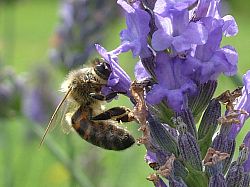Research shows bumblebees on lavender have it licked
New research by the University of Sussex shows why lavender flowers attract more bumblebees than honey bees: it’s down to the bumblebee’s longer tongue and ability to visit flowers more quickly.
 Honey bee on lavender 'Grosso'
Honey bee on lavender 'Grosso'
The tubular flowers of lavender make nectar extraction harder for the shorter-tongued honey bee, which has to jam its head into each flower to get to the nectar, the researchers observed when studying bees that were visiting an experimental flower garden on campus.
Bumblebees spent 1.1-1.4 seconds per lavender flower, as opposed to the slower honey bee’s 3.5 seconds per flower.
Nick Balfour, who is studying for a doctorate in the Laboratory of Apiculture and Social Insects (LASI), supported by Waitrose and the CB Dennis Research Trust, says: “Lavender is a very popular plant, but with so many visitors the amount of nectar available per lavender flower is minuscule.
“We estimate it would take a bee one week and 300,000 flower visits to collect just one teaspoon of lavender nectar. With such small rewards on offer the faster-handling bumblebees can do much better than honey bees on lavender."
Professor Francis Ratnieks, who is LASI Director and who supervised the research, says: “It has been known for a long time that bumblebees have longer tongues than honey bees. Our research shows that on lavender this difference is crucial.”
That is because bee foraging is about efficiency. The quicker a bee can visit a flower, the more food it can bring back for its colony. Two seconds faster might not seem much but, multiplied over thousands of flowers, the benefit is significant.
Professor Ratnieks says: “It is very easy to see by eye how much quicker bumblebees are than honey bees to visit lavender flowers, and how the honey bees seem to push their heads into the flower more than bumblebees. Have a look this summer.”
The research findings are published online in Ecological Entomology.
